Abstract
Photocatalysis is a hopeful technology to solve various environmental problems, but it is still a technical task to produce large-scale photocatalysts in a simple and sustainable way. Here, nano-flower β-Bi2O3/TiO2 composites were prepared via a facile solvothermal method, and the photocatalytic performances of β-Bi2O3/TiO2 composites with different Bi/Ti molar ratios were studied. The nano-flower Bi2O3/TiO2 composites were studied by SEM, XRD, XPS, BET, and PL. The PL result proved that the construction of staggered heterojunction enhanced the separation efficiency of carriers. The degradation RhB was applied to study the photocatalytic performances of prepared materials. The results showed that the degradation efficiency of RhB increased from 61.2% to 99.6% when the molar ratio of Bi/Ti was 2.1%. It is a mesoporous approach to enhance photocatalytic properties by forming heterojunction in Bi2O3/TiO2 composites, which increases the separation efficiency of the generated carriers and improves photocatalytic properties. The photoactivity of the Bi2O3/TiO2 has no evident changes after the fifth recovery, indicating that the Bi2O3/TiO2 composite has distinguished stability.
1. Introduction
Environmental pollution and destruction are becoming a vertical global crisis. Organic dye pollutants are directly discharged into water from dyeing textiles. Most dyes, such as RhB, MB, MR, and EY, are non-biodegradable and carcinogenic, which has brought damage to environment and human health [1]. Therefore, developing an environmental harmony, ecological cleanliness, and safe and energy-saving treatment technology for the problem of environment contamination is the most important immediate challenge that human beings must face [2,3,4].
Photocatalysis offers a clean, gentle reaction conditions, an easy procedure, and safe technology that can degrade the pollution under solar irradiation [4,5,6,7]. Photocatalytic technology plays a significant role in the field of environmental pollution protection [8,9,10]. Metal oxide semiconductors have garnered great attention in pollution treatment owing to their cheap and easy synthesis [11,12]. As a classic semiconductor, titanium dioxide (TiO2) is the one most generally cited in photocatalytic technology in virtue of its chemical stability, nontoxicity, low price, and high activity [13]. The photocatalytic reaction system and reaction mechanism of TiO2 were studied [14,15]. In particular, TiO2 photocatalysts have been explored broadly in the area of environmental pollution and energy transformation [16,17,18]. However, the TiO2 photocatalysts also expose many problems, such as the large band gap (3.2 eV), absorption narrow wavelength range light, easy recombination with photogenerated electrons, and holes, which bring about lower photocatalytic efficiency, limiting its application [19,20]. For this reason, modification of TiO2 for enhancing its photocatalytic properties is needed and crucial. Many different means have been tried by researchers to change the surface or comprehensive performances of TiO2, for instance, doping metal [21], structural adjustment [22], and heterogeneous structure [23,24], thereby promoting the photocatalytic properties. In these modifications, construction of heterojunctions is a promising strategy to improve the separation efficiency of photogenerated charge carriers. TiO2 united with narrow bandgap semiconductors that are visible-light-responsive would extend the light absorption range and decrease the combination of photogenerated charge carriers, for example, TiO2/ZnFe2O4 [25], CdS/TiO2 [26], g-C3N4/TiO2 [27], and InVO4/TiO2 [28].
Among these visible-light-responsive and narrow band gap semiconductors, bismuth oxide (Bi2O3) is an up-and-coming semiconductor to construct heterojunctions with TiO2, in which the band gap is lower than that of TiO2 [29]. When Bi2O3 is irradiated with visible light, photogenerated holes of the valence band of Bi2O3 have strong oxidation, which is beneficial to degrade the pollutions. In addition, Bi2O3 has been under comprehensive study due to its excellent physical and chemical properties, low price, and non-toxicity [30,31,32]. Bi2O3 has α, β, γ, δ, ε, and ω phases, i.e., six kinds of polymorphs [33]. In particular, β-Bi2O3 possesses high light-absorption performances among the six polymorphs, and the band gap is about 2.3 eV [34]. Therefore, the construction of β-Bi2O3/TiO2 heterojunction structures can be carried out to increase the light response and photocatalytic performances. However, for the case of β-Bi2O3/TiO2 photocatalytic composites, the preparation methods are complex, including a two-step procedure, photo-deposition, deposition-reduction, and impregnation method [35,36].
Here, in this paper, the β-Bi2O3/TiO2 heterojunction photocatalysts were prepared via a simple, one-step solvothermal method. The influences of the molar ratios of β-Bi2O3/TiO2 on the photocatalytic degradation of RhB for β-Bi2O3/TiO2 were assessed. In the meantime, the morphology, crystal structure, surface chemical optical state, and photoelectrochemical properties of photocatalysts were investigated.
2. Results and Discussion
2.1. Characterization of Photocatalysts
Figure 1 shows the XRD patterns of pure Bi2O3, pure TiO2, and Bi2O3/TiO2 photocatalysts with different molar ratios of Bi. For the pure TiO2, the diffraction peaks are at 25.3°, 37.8°, 48.1°, 53.9°, and 62.7°, coinciding with (101), (004), (200), (105), and (204) of the anatase TiO2 (JCPDS No.21-1272) [37]. For pure Bi2O3, the diffraction peaks are corresponding to β-Bi2O3 [32]. For Bi2O3/TiO2 composites with different molar ratios of Bi, it is evident that the diffraction peaks are similar to pure TiO2 and correspond to the anatase TiO2. The diffraction peak of the Bi phase is not observed in Bi2O3/TiO2 composites for several reasons. The size of Bi is extremely small and highly dispersed, and the doping amount of Bi is too small [36]. There are similar results in the reported literatures [38]. For example, Zhu et al. [39] found that Bi2O3/TiO2 lacks the Bi2O3 diffraction even when the Bi/Ti ratio in Bi2O3/TiO2 was 4.1%.
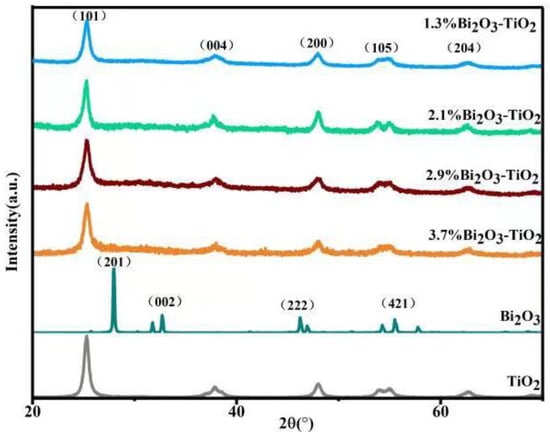
Figure 1.
The XRD patterns of β -Bi2O3, TiO2, and Bi2O3/TiO2 composites.
The morphologies of materials were analyzed via SEM and HRTEM, and the images are displayed in Figure 2 and Figure 3. In Figure 2a, the pure Bi2O3 reveals a stuffed, coral-like sphere with a diameter between 50–150 nm. The pure TiO2 exhibits a flower-like structure (Figure 2b). As shown in Figure 2c–f, the Bi2O3/TiO2 composites in different molar ratios of Bi display a flower-like structure that is similar to the morphology of pure TiO2. It indicates that the incorporation of Bi2O3 does not influence the topography of TiO2. In addition, the diameter of the flower-like structure of Bi2O3/TiO2 composites is between 5 μm–10 μm, and the thickness diameter of the flower-like structure is about 65 nm. Meanwhile, the EDS was applied to investigate the elemental contents of 2.1% Bi2O3/TiO2, and the atomic ratio of Bi/Ti is about 2.9%, as displayed in Table 1.
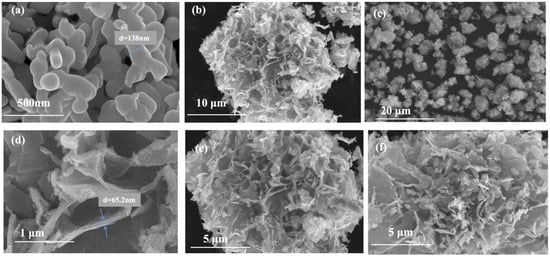
Figure 2.
The SEM images of (a) β-Bi2O3, (b) TiO2, and (c) 2.1%Bi2O3/TiO2; (d) petal diameter of 2.1%Bi2O3/TiO2, (e) 2.9% Bi2O3/TiO2, and (f) 3.7% Bi2O3/TiO2.
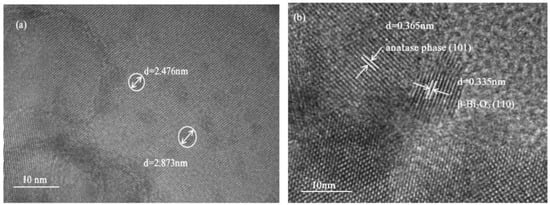
Figure 3.
The (a) TEM and (b) HRTEM of 2.1% Bi2O3/TiO2.

Table 1.
The elemental contents of 2.1% Bi2O3/TiO2 from EDS.
From the TEM images of Bi2O3/TiO2 composites (Figure 3a), some nanoparticles with a diameter between 2~3 nm are evenly spread on the TiO2. The HRTEM image of Bi2O3/TiO2 composites (Figure 3b) shows that the lattice fringe is about 0.335 nm, assigned to (110) of β-Bi2O3. This indicates that β-Bi2O3 is present in the Bi2O3/TiO2 composites. Moreover, the crystal lattice fringe of 0.365 nm is corresponding to the (101) plane of anatase TiO2. This indicates that the Bi2O3 and TiO2 are closely interlinked. Due the deposition of Bi2O3 on TiO2, it could be profitable to the carriers migrate between Bi2O3 and TiO2 and enhance the separation efficiency of carriers as well as the photocatalytic properties. Furthermore, the crystallite size of Bi2O3/TiO2 composites decreased compared with Bi2O3 and TiO2 [40].
The chemical compositions and element valence state of 2.1%Bi2O3/TiO2 photocatalysts were studied through XPS. Figure 4a displays the XPS survey scan of 2.1%Bi2O3/TiO2, which demonstrates that the presence of Bi, O, and Ti elements can be seen in Bi2O3/TiO2 composites. It indicates that the Bi2O3/TiO2 composites managed to compound by solvothermal method. The high-resolution XPS for Bi 4f of Bi2O3/TiO2 composites is displayed in Figure 4b, and the two main peaks at 159.19 eV and 164.43 eV are corresponding to the Bi 4f7/2 and Bi 4f5/2, respectively, which indicates the presence of Bi3+ [41]. In additional, the peaks at 157.43 eV and 162.63 eV are attributed to the Bi 0 (metallic Bi) [42], indicating that the Bi3+ and metallic Bi are both in Bi2O3/TiO2 composites. Ti 2p peaks of Bi2O3/TiO2 composites are fitted by two XPS peaks (Figure 4c), and the two peaks at 458.19 eV and 463.81 eV are assigned to Ti 2p3/2 and Ti 2p1/2, respectively, showing the existence of Ti4+ [43]. The high-resolution XPS O1s of Bi2O3/TiO2 composites located at 529.36 eV, 530.04 eV, and 531.71 eV belong to lattice oxygen in Bi-O of Bi2O3, Ti-O of TiO2, and surface absorbed hydroxyl groups, respectively (Figure 4d) [44]. It is worth noting that the binding energies of Ti 2p and O1s in 2.1% Bi2O3/TiO2 are shifted towards lower binding energies compared to TiO2, while Bi 4f binding energy is shifted to high binding energy compared to B2O3. In conclusion, the XPS results indicate strong interactions and electron transfer between Bi2O3 and TiO2 in Bi2O3/TiO2.
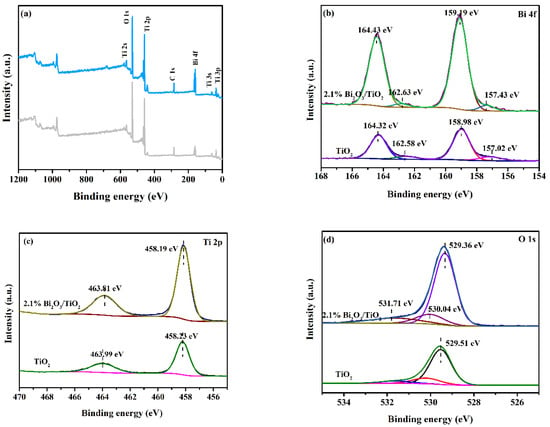
Figure 4.
XPS full-spectrum map of 2.1% Bi2O3/TiO2 (a) and high-resolution spectrum map of (b) Bi 4f, (c) Ti 2p, and (d) O 1s.
The specific surface areas are important elements to influence the catalytic properties. Therefore, the nitrogen adsorption–desorption isotherm was employed to evaluate the BET surface area of β-Bi2O3, TiO2, and Bi2O3/TiO2 photocatalysts, and the results are shown in Figure 5. The isotherms of all photocatalysts are typical type IV, and the H3 hysteresis loop in the light of IUPAC classification can be observed [45]. It indicates that the β-Bi2O3, TiO2, and Bi2O3/TiO2 photocatalysts are mesoporous structures. The BET specific surface areas of β-Bi2O3, TiO2, and Bi2O3/TiO2 photocatalysts are 3.1, 8.7, and 42.0 m2/g, respectively. Apparently, the specific surface area of Bi2O3/TiO2 composites is considerably increased after the fusion of Bi2O3 on TiO2 compared with pure TiO2. With the increase of calcination temperature, Bi5O7NO3 gradually transformed to β- Bi2O3, and the following decomposition reaction (Bi5O7NO3 → 5/2Bi2O3+NO+3/4O2) occurs at the calcination temperature. The products of NO and O2 during the decomposition of Bi5O7NO3 will affect the crystallization process of TiO2, thus making the TiO2 structure looser and producing many pores, increasing the specific surface area of the composite. From the SEM results, it can be seen that more holes are formed after the combination of Bi2O3 and TiO2, increasing the specific surface area. In addition, it was reported that the higher specific surface area was frequently accompanied by higher adsorption properties and active sites [46]. Therefore, the Bi2O3/TiO2 composites have a higher adsorption capacity and active sites, indicating the improvement of photocatalytic properties.
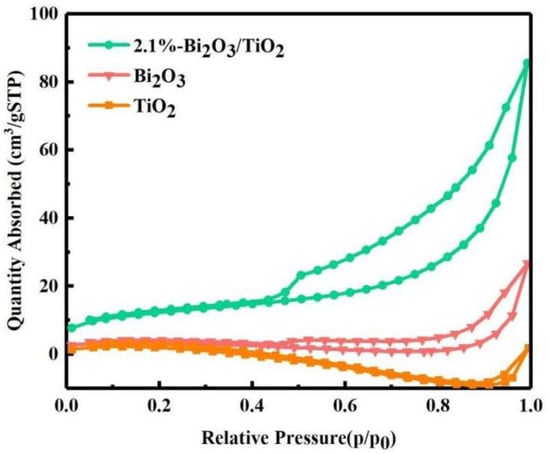
Figure 5.
N2 adsorption–desorption isotherm of 2.1%Bi2O3/TiO2, Bi2O3, and TiO2.
2.2. Analysis of Optical and Photoelectrochemical Performances
The optical properties of pure Bi2O3, pure TiO2, and Bi2O3/TiO2 composites were assessed through UV–vis DRS. As displayed in Figure 6a, obviously, the absorption edge of TiO2 is about 400 nm in the UV spectrum. However, the Bi2O3 has a larger absorption range, and the absorption edge is about 500 nm. For Bi2O3/TiO2 composites, the absorption edges are red-shifted in comparison to the pure TiO2, particularly 2.1% Bi2O3/TiO2 composites. Therefore, after incorporation of Bi2O3, it is profitable to increase the light energy acquirement and visible light absorption for pure TiO2. It would help to separate the photogenerated carriers and increase the properties of degradation of RhB. Further, the Kubelka–Munk formula (αhυ = A(hυ − Eg)n/2) was employed to count the band-gap energy of catalysts [47]. The band gap of pure TiO2, pure Bi2O3, and 2.1% Bi2O3/TiO2 samples are about 3.1 eV, 2.72 eV, and 2.79 eV, respectively (Figure 6b).
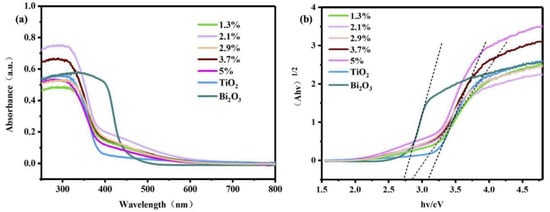
Figure 6.
(a) UV–vis spectrum and (b) the band gap of Bi2O3/TiO2, Bi2O3, and TiO2.
Photoluminescence (PL) was applied to measure the separating efficiency of photogenerated electrons and holes of prepared samples because of its high sensitivity and because it does not destroy contaminated samples. Figure 7 shows the PL results of pure TiO2, 1.3% Bi2O3/TiO2, 2.1% Bi2O3/TiO2, 2.9% Bi2O3/TiO2, 3.7% Bi2O3/TiO2, and 5% Bi2O3/TiO2, respectively. It is evident that the PL intensities of all Bi2O3/TiO2 photocatalysts are less than that of pure TiO2, implying that the construction of Bi2O3/TiO2 restrains the regroup of photogenerated electrons and holes. Meanwhile, the 2.1% Bi2O3/TiO2 composite has the lowest intensity, which implies that the separation efficiency of photoinduced carriers is highest, corresponding to the high degradation rate of RhB [45].
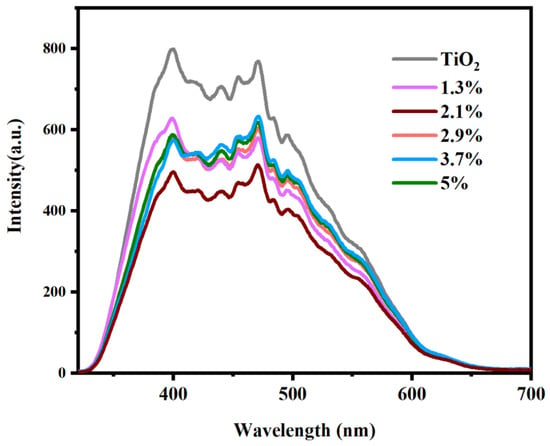
Figure 7.
PL fluorescence profiles of TiO2 and Bi2O3/TiO2.
2.3. Photocatalytic Performance Analysis
The photocatalytic properties of pure TiO2, pure Bi2O3, and Bi2O3/TiO2 composites were assessed by degrading the RhB via simulation sunlight, and the consequences are displayed in Figure 8. The experiment is divided into two steps: first, in order to achieve concentration balance, the photocatalysts adsorbed the RhB for 30 min under dark reactions; then, the photocatalysts were illuminated under simulated sunlight by xenon lamp. Figure 8a presents the impact of Bi2O3 ratio on TiO2 photocatalytic properties. It is found that the pure Bi2O3, pure TiO2, and Bi2O3/TiO2 composites have lower absorption ability in the dark after 30 min. However, the photocatalytic performances of Bi2O3/TiO2 composites with simulated sunlight increased first with the enhancement of Bi2O3 content, and the 2.1% Bi2O3/TiO2 composites exhibited exceptional photocatalytic abilities. The degradation rate of RhB can reach 99.6% under the irradiation of simulation sunlight for 60 min, which is about 0.63 of the time and six times better than pure TiO2 and pure Bi2O3, respectively. It is mainly because of the constitution of the heterojunction between Bi2O3 and TiO2, which restricts the combination of carriers and thus enhances the photocatalytic properties of the photocatalyst. However, the photocatalytic properties of Bi2O3/TiO2 catalysts declined when increasing the Bi2O3 content from 2.9% to 5%, which may be the result of the aggregates of the Bi2O3 and the drop of active sites. On the other hand, the excessive Bi2O3 can be considered as the recombination center, which results in the decrease of photocatalytic properties. The excessive Bi2O3 would influence the transmission of light between the Bi2O3 and TiO2, blocking the motivation of TiO2 and resulting in reducing the photocatalytic efficiency of photocatalysts [48]. Moreover, the catalytic performances of different Bi2O3/TiO2 reported in other papers were compared, and the details are listed in Table 2. It can be seen that the β-Bi2O3/TiO2 photocatalyst in this work shows the efficient photocatalytic performance for photodegradation RhB.
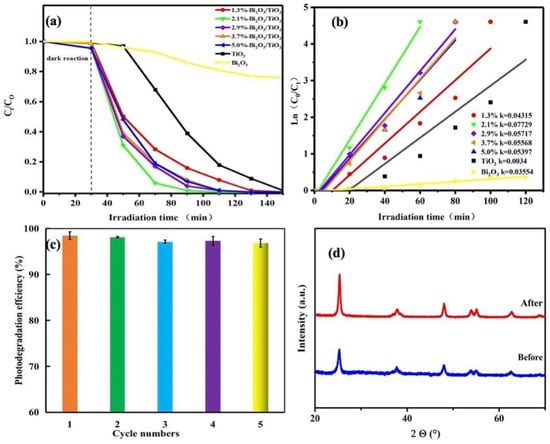
Figure 8.
(a) Photocatalytic degradation RhB of catalysts, (b) reaction kinetic constants for degradation, (c) recycle stability of 2.1% Bi2O3/TiO2 composites for RhB degradation, and (d) the XRD of before photodegradation and five cycles of photogradation of 2.1% Bi2O3/TiO2 composites.

Table 2.
Comparative performance of Bi2O3/TiO2 materials for photocatalytic dye photodegradation.
Meanwhile, the first-order reaction rate constant (k) determined by quasi-first-order kinetic model was applied to study the photocatalytic processes. As shown in Figure 8b, the k values of TiO2, Bi2O3, 1.3%Bi2O3/TiO2, 2.1% Bi2O3/TiO2, 2.9% Bi2O3/TiO2, 3.7% Bi2O3/TiO2, and 5% Bi2O3/TiO2 are 0.03654 h−1, 0.0034 h−1, 0.04315 h−1, 0.07729 h−1, 0.05717 h−1, 0.05568 h−1, and 0.05397 h−1, respectively. It is obvious that the k value of 2.1% Bi2O3/TiO2 composites is the maximum, which is 2.1 and 22.7 times of TiO2 and Bi2O3, respectively. The result shows that the 2.1% Bi2O3/TiO2 composites display preferable photocatalytic activity compared to other catalysts. In addition, the recycling stability of the 2.1% Bi2O3/TiO2 composites was assessed. As represented in Figure 8c, the photocatalytic activity of 2.1% Bi2O3/TiO2 composites not to have obvious change after five trials, indicating the outstanding stability and repeatability. Further, in order to verify the stability of 2.1% Bi2O3/TiO2 composites, the XRD was employed to analyze the structure of 2.1% Bi2O3/TiO2 composites before and after five trials, as shown in Figure 8d. It can be seen that there is no obvious change in 2.1% Bi2O3/TiO2 composites before and after five trials, which also implies the stability of Bi2O3/TiO2 composites.
Based on the above analysis, a potential degradation mechanism is put forward. As represented in Figure 9, when the Bi2O3/TiO2 photocatalyst is illuminated by simulated sunlight, the photogenerated electrons (e−) are activated and diverted from the CB of TiO2 to the CB of Bi2O3 via the interface of Bi2O3/TiO2 composites; meanwhile, the holes (h+) are transferred from the VB of Bi2O3 to the VB of TiO2; therefore, the photoinduced holes accumulate in the heterojunction interface, which is favorable for the separation of photogenerated electrons and holes. The photogenerated electron and holes could have the following reactions [52]: On the one hand, the electrons react with O2 in the solution to produce •O2−. Then, the H+ react with the •O2− to generate H2O2, which then reacts with electrons to transform •OH. On the other hand, the h+ on the VB of TiO2 oxides the H2O/OH- to form •OH radicals for RhB degradation. Therefore, the Bi2O3/TiO2 composites have higher photocatalytic activity.
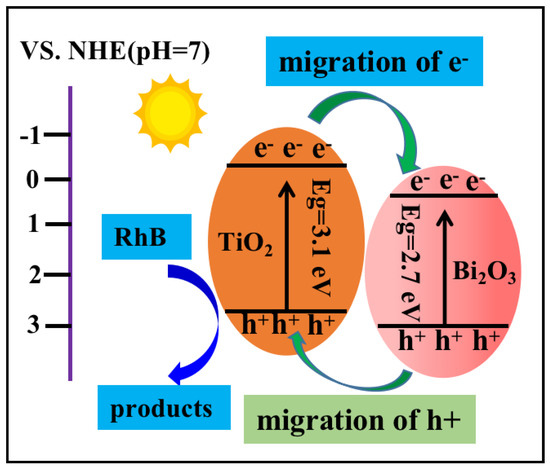
Figure 9.
Photocatalytic mechanism based on degradation of the RhB of the Bi2O3/TiO2 photocatalyst.
3. Experimental
3.1. Chemicals
Titanium tetrachloride was purchased from Shanghai Nuotai Chemical Co., Ltd, Shanghai, China. Sinopharm Chemical Reagent Co., Ltd, Shanghai, China. provided nitric acid (HNO3, AR), bismuth nitrate pentahydrate (Bi(NO3)3·5H2O, AR), and sodium bicarbonate (NaHCO3, AR). Sodium hydroxide (NaOH, AR) and glycerol were obtained from Xilong Chemical Co., Ltd, Guangzhou, China. Ethanol (CH3CH2O, AR) was obtained from Aladdin. Rhodamine B was provided by Shanghai Yuanye Biotechnology Co., Ltd, Shanghai, China.
3.2. Preparation of β-Bi2O3/TiO2 Photocatalysts
Bi(NO3)3·5H2O, 30 mL glycerin, and 20 mL ethanol were mixed together and then stirred for 30 min and sonicated for 1 min. The mixtures were poured into a Teflon-sealed reactor. Titanium tetrachloride was added drop by drop into the solution. Then, the Teflon-sealed reactor was put into an oven and heated for 48 h at 110 °C. When the temperature dropped to 25 °C, the reaction productions were collected and washed with ethanol several times and dried at 80 °C for 6 h to obtain the material. The material was calcined at 375 °C for 4 h to obtain the product. The molar ratios of Bi/Ti in the composites were settled at 1.3%, 2.1%, 2.9%, 3.7%, and 5.0%, which were calculated by theoretical methods. The as-prepared photocatalytics were denoted as 1.3%, 2.1%, 2.9%, 3.7%, and 5.0% Bi2O3/TiO2, which are based on the molar ratio of Bi/Ti. As a comparison, pure Bi2O3 and TiO2 samples were prepared with the same procedure.
3.3. Characterization
The crystal structure was studied by a X-ray diffraction (XRD, RiGdku, RINT2000 with Cu K α radiation (λ = 0.15418 nm). The morphologies of photocatalysts were studied through a field-induced emission scanning electron microscope (FESEM, JSM-6700F). The transmission electron microscopy (TEM) was employed by JEM-2010F, and the accelerating voltage was 200 kV. The Brunauer–Emmett–Teller (BET) specific surface area of prepared photocatalysts was recorded on a Quantachrome NOVA 2000e. A UV–vis scanning spectrophotometer (UV–vis/DRS, SHIMADZU UV-2450) was applied to investigate the optical properties of the prepared photocatalysts. The photoluminescence (PL) was measured by a Hitachi F4500 fluorescence spectrometer. The X-ray photoelectron spectroscopy (XPS, ESCALAB MK II) was employed to analyze the elemental compositions of the samples.
3.4. Photocatalytic Activity Analysis
The photocatalytic properties of all photocatalysts were analyzed by degrading rhodamine B (RhB) with simulation sunlight illumination. The illuminant was a 300 W Xe lamp (PLS-SXE300, Beijing Park Lay Technology Co., Ltd., Beijing, China), and the light intensity was 100 mW/cm2. Briefly, the photocatalyst (50 mg) was placed into 60 mL of 20 mg/L of RhB solution. Before exposure to light, the mixture solution was stirred for 30 min to obtain adsorption equilibrium. Then, 3 mL of solution was extracted and centrifuged at 20 min intervals. The RhB concentration was recorded through the UV–vis spectrophotometer. The stability of Bi2O3/TiO2 photocatalyst was studied via five recycling experiments, and the results were the average value of three samples.
4. Conclusions
In this study, flower-like Bi2O3/TiO2 photocatalysts were successfully prepared by solvothermal route, and XRD, SEM, TEM, XPS, BET, UV–vis, and PL were employed to analyze the morphology and properties of the photocatalysts. The influence of doped Bi2O3 content on TiO2 photocatalytic efficiency was determined. The XRD results implied that the presence of Bi2O3 did not destroy the lattice structure of TiO2. The photocatalytic properties of materials were studied via RhB degradation. A significantly improvement in photoactivity was obtained when the heterojunction was created between Bi2O3 and TiO2. Further, the 2.1% Bi2O3/TiO2 photocatalyst has the best degradation efficiency, which is 99.6% degradation of RhB at 60 min. It is mainly because the heterojunction in Bi2O3/TiO2 strengthens the movement and separation of carriers and then enhances the photocatalytic properties of the Bi2O3/TiO2.
Author Contributions
Experiments, M.W. and C.L.; Analysed, B.L. and W.Q.; Writing, M.W., C.L. and B.L.; Revised, W.Q.; Funding, Y.X. and M.W. All authors have read and agreed to the published version of the manuscript.
Funding
This work was financially supported by the Science and Technology Department of Jiangxi Province (20181ACG70025) and the Key Project of Science and Technology Research of Jiangxi Provincial Department of Education (No. GJJ191044). This work was also supported by Shanghai Summit Discipline in Design (SJGFXK-2019-001), Jiangxi Province “double thousand plan” project (jxsq2019201007), and Jiangxi Province’s Scientific Planning Project (No. YG2021057).
Institutional Review Board Statement
Not applicable.
Informed Consent Statement
Not applicable.
Data Availability Statement
Data of the present study are available in the article.
Conflicts of Interest
The authors declare no conflict of interest.
Sample Availability
Samples of the compounds are available from the authors.
References
- Mukhtar, F.; Munawar, T.; Nadeem, M.S.; Khan, S.A.; Koc, M.; Batool, S.; Hasan, M.; Iqbal, F. Enhanced sunlight-absorption of Fe2O3 covered by PANI for the photodegradation of organic pollutants and antimicrobial inactivation. Adv. Powder Technol. 2022, 33, 103708. [Google Scholar] [CrossRef]
- Luo, J.; Dai, Z.; Feng, M.; Gu, M.; Xie, Y. Graphitic carbon nitride/ferroferric oxide/reduced graphen oxide nanocomposite as highly active visible light photocatalyst. Nano Res. 2022, 16, 371–376. [Google Scholar] [CrossRef]
- Cui, H.; Zhou, Y.; Mei, J.; Li, Z.; Xu, S.; Yao, C. Synthesis of CdS/BiOBr nanosheets composites with efficient visible-light photocatalytic activity. J. Phys. Chem. Solids 2018, 112, 80–87. [Google Scholar] [CrossRef]
- Weng, B.; Lu, K.-Q.; Tang, Z.; Chen, H.M.; Xu, Y.-J. Stabilizing ultrasmall Au clusters for enhanced photoredox catalysis. Nat. Commun. 2018, 9, 1543. [Google Scholar] [CrossRef] [PubMed]
- Huang, H.; Verhaeghe, D.; Weng, B.; Ghosh, B.; Zhang, H.; Hofkens, J.; Steele, J.A.; Roeffaers, M.B.J. Metal Halide Perovskite-Based Heterojunction Photocatalysts. Angew. Chem. Int. Ed. 2022, 134, e202203261. [Google Scholar]
- Liao, H.; Liu, C.; Zhong, J.; Li, J. Fabrication of BiOCl with adjustable oxygen vacancies and greatly elevated photocatalytic activity by using bamboo fiber surface embellishment. Colloids Surf. A Physicochem. Eng. Asp. 2022, 634, 127892. [Google Scholar] [CrossRef]
- Jiang, L.; Guo, Y.; Pan, J.; Zhao, J.; Ling, Y.; Xie, Y.; Zhou, Y.; Zhao, J. N, P, O co-doped carbon filling into carbon nitride microtubes to promote photocatalytic hydrogen production. Sci. Total Environ. 2022, 809, 151114. [Google Scholar] [CrossRef]
- Huang, H.; Zhao, J.; Weng, B.; Lai, F.; Zhang, M.; Hofkens, J.; Roeffaers, M.B.J.; Steele, J.A.; Long, J. Site-Sensitive Selective CO2 Photoreduction to CO over Gold Nanoparticles. Angew. Chem. Int. Ed. 2022, 134, e202204563. [Google Scholar]
- Wu, W.; Sun, Y.; Zhou, H. In-situ construction of β-Bi2O3/Ag2O photocatalyst from deactivated AgBiO3 for tetracycline degradation under visible light. Chem. Eng. J. 2022, 432, 134316. [Google Scholar] [CrossRef]
- Shen, Z.; Zhou, Y.; Guo, Y.; Zhao, J.; Song, J.; Xie, Y.; Ling, Y.; Zhang, W. Tuning the concentration of surface/bulk oxygen vacancies in CeO2 nanorods to promote highly efficient photodegradation of organic dyes. Chin. Chem. Lett. 2021, 32, 2524–2528. [Google Scholar] [CrossRef]
- Mukhtar, F.; Munawar, T.; Nadeem, M.S.; ur Rehman, M.N.; Mahmood, K.; Batool, S.; Hasan, M.; ur Rehman, K.; Iqbal, F. Enhancement in carrier separation of ZnO-Ho2O3-Sm2O3 hetrostucturednanocomposite with rGO and PANI supported direct dual Z-scheme for antimicrobial inactivation and sunlight driven photocatalysis. Adv. Powder Technol. 2021, 32, 3770–3787. [Google Scholar] [CrossRef]
- Mukhtar, F.; Munawar, T.; Nadeem, M.S.; ur Rehman, M.N.; Batool, S.; Hasan, M.; Riaz, M.; ur Rehman, K.; Iqbal, F. Highly efficient tri-phase TiO2–Y2O3–V2O5 nanocomposite: Structural, optical, photocatalyst, and antibacterial studies. J. Nanostruct. Chem. 2022, 12, 547–564. [Google Scholar] [CrossRef]
- Qutub, N.; Singh, P.; Sabir, S.; Sagadevan, S.; Oh, W.C. Enhanced photocatalytic degradation of Acid Blue dye using CdS/TiO2 nanocomposite. Sci. Rep. 2022, 12, 5759. [Google Scholar] [CrossRef] [PubMed]
- Chen, L.; Song, X.-L.; Ren, J.-T.; Yuan, Z.-Y. Precisely modifying Co2P/black TiO2 S-scheme heterojunction by in situ formed P and C dopants for enhanced photocatalytic H2 production. Appl. Catal. B Environ. 2022, 315, 121546. [Google Scholar] [CrossRef]
- Nemiwal, M.; Zhang, T.C.; Kumar, D. Recent progress in g-C3N4, TiO2 and ZnO based photocatalysts for dye degradation: Strategies to improve photocatalytic activity. Sci. Total Environ. 2021, 767, 144896. [Google Scholar] [CrossRef]
- Zhu, G.; Feng, S.; Chao, J.; Zheng, W.; Shao, C. One-pot synthesis of C-dots modified TiO2 nanosheets/UiO-66-NH2 with improved photocatalytic activity under visible light. Ceram. Int. 2020, 46, 2530–2537. [Google Scholar] [CrossRef]
- Li, Z.; Wang, S.; Wu, J.; Zhou, W. Recent progress in defective TiO2 photocatalysts for energy and environmental applications. Renew. Sustain. Energy Rev. 2022, 156, 111980. [Google Scholar] [CrossRef]
- Jin, Y.; Tang, W.; Wang, J.; Ren, F.; Chen, Z.; Sun, Z.; Ren, P.-G. Construction of biomass derived carbon quantum dots modified TiO2 photocatalysts with superior photocatalytic activity for methylene blue degradation. J. Alloys Compd. 2023, 932, 167627. [Google Scholar] [CrossRef]
- Tashkandi, N.Y.; Albukhari, S.M.; Ismail, A.A. Visible-light driven of heterostructured LaFeO3/TiO2 photocatalysts for degradation of antibiotics: Ciprofloxacin as case study. J. Photochem. Photobiol. A Chem. 2022, 432, 114078. [Google Scholar] [CrossRef]
- Wang, H.; Song, L.; Yu, L.; Xia, X.; Bao, Y.; Lourenco, M.; Homewood, K.; Gao, Y. Charge transfer between Ti4+, Sn4+ and Pt in the tin doped TiO2 photocatalyst for elevating the hydrogen production efficiency. Appl. Surf. Sci. 2022, 581, 152202. [Google Scholar] [CrossRef]
- Basavarajappa, P.S.; Patil, S.B.; Ganganagappa, N.; Reddy, K.R.; Raghu, A.V.; Reddy, C.V. Recent progress in metal-doped TiO2, non-metal doped/codoped TiO2 and TiO2 nanostructured hybrids for enhanced photocatalysis. Int. J. Hydrogen Energy 2020, 45, 7764–7778. [Google Scholar] [CrossRef]
- Zhang, C.; Zhou, Y.; Bao, J.; Fang, J.; Zhao, S.; Zhang, Y.; Sheng, X.; Chen, W. Structure regulation of ZnS@g-C3N4/TiO2 nanospheres for efficient photocatalytic H2 production under visible-light irradiation. Chem. Eng. J. 2018, 346, 226–237. [Google Scholar] [CrossRef]
- Niu, M.; Cao, D.; Sui, K.; Liu, C. InP/TiO2 heterojunction for photoelectrochemical water splitting under visible-light. Int. J. Hydrogen Energy 2020, 45, 11615–11624. [Google Scholar] [CrossRef]
- Meng, A.; Cheng, B.; Tan, H.; Fan, J.; Su, C.; Yu, J. TiO2/polydopamine S-scheme heterojunction photocatalyst with enhanced CO2-reduction selectivity. Appl. Catal. B Environ. 2021, 289, 120039. [Google Scholar] [CrossRef]
- Zeng, D.; Wang, J.; Xie, Y.; Ling, Y.; Zhao, J.; Ye, H.; Chen, T. TiO2@ZnFe2O4 heterojunctions for effecicent photocatalytic degradation of persistent pollutants and hydrogen evolution. Mater. Chem. Phys. 2022, 277, 125462. [Google Scholar] [CrossRef]
- Ge, H.; Xu, F.; Cheng, B.; Yu, J.; Ho, W. S-Scheme heterojunction TiO2/CdS nanocomposite nanofiber as H2-production photocatalyst. ChemCatChem 2019, 11, 6301–6309. [Google Scholar] [CrossRef]
- Wang, J.; Wang, G.; Cheng, B.; Yu, J.; Fan, J. Sulfur-doped g-C3N4/TiO2 S-scheme heterojunction photocatalyst for Congo Red photodegradation. Chin. J. Catal. 2021, 42, 56–68. [Google Scholar] [CrossRef]
- Zhang, X.; Shi, Q.; Liu, X.; Li, J.; Xu, H.; Ding, H.; Li, G. Facile Assembly of InVO4/TiO2 Heterojunction for Enhanced Photo-Oxidation of Benzyl Alcohol. Nanomaterials 2022, 12, 1544. [Google Scholar] [CrossRef]
- Lu, H.; Hao, Q.; Chen, T.; Zhang, L.; Chen, D.; Ma, C.; Yao, W.; Zhu, Y. A high-performance Bi2O3/Bi2SiO5 p-n heterojunction photocatalyst induced by phase transition of Bi2O3. Appl. Catal. B Environ. 2018, 237, 59–67. [Google Scholar] [CrossRef]
- Bao, Y.; Lim, T.-T.; Zhong, Z.; Wang, R.; Hu, X. Acetic acid-assisted fabrication of hierarchical flower-like Bi2O3 for photocatalytic degradation of sulfamethoxazole and rhodamine B under solar irradiation. J. Colloid Interface Sci. 2017, 505, 489–499. [Google Scholar] [CrossRef]
- Jiang, T.; Cheng, L.; Han, Y.; Feng, J.; Zhang, J. One-pot hydrothermal synthesis of Bi2O3-WO3 p-n heterojunction film for photoelectrocatalytic degradation of norfloxacin. Sep. Purif. Technol. 2020, 238, 116428. [Google Scholar] [CrossRef]
- Tang, X.; Ma, C.; Liu, N.; Liu, C.; Liu, S. Visible light β-Bi2O3/BiOCl heterojunction photocatalyst with highly T enhanced photocatalytic activity. Chem. Phys. Lett. 2018, 709, 82–87. [Google Scholar] [CrossRef]
- Majumder, S.; Quang, N.D.; Hien, T.T.; Chinh, N.D.; Yang, H.; Kim, C.; Kim, D. Nanostructured β-Bi2O3/PbS heterojunction as np-junction photoanode for enhanced photoelectrochemical performance. J. Alloys Compd. 2021, 870, 159545. [Google Scholar] [CrossRef]
- Liu, X.; Kang, Y.; Wang, Y. Novel high-efficiency visible-light-driven p-n heterojunction beta-Bi2O3/Ag2WO4 photocatalysts. Chem. Phys. Lett. 2022, 790, 139347. [Google Scholar] [CrossRef]
- Lou, B.; Chen, C.; Liu, J.; Zou, S.; Xiao, L.; Fan, J. Selectively depositing Bi2O3 quantum dots on TiO2 nanotubes for efficient visible-light-driven photocatalysis. Mater. Lett. 2021, 288, 129413. [Google Scholar] [CrossRef]
- Reddy, N.L.; Emin, S.; Valant, M.; Shankar, M.V. Nanostructured Bi2O3@TiO2 photocatalyst for enhanced hydrogen production. Int. J. Hydrogen Energy 2017, 42, 6627–6636. [Google Scholar] [CrossRef]
- Wei, K.; Armutlulu, A.; Wang, Y.; Yao, G.; Xie, R.; Lai, B. Visible-light-driven removal of atrazine by durable hollow core-shell TiO2@LaFeO3 heterojunction coupling with peroxymonosulfate via enhanced electron-transfer. Appl. Catal. B Environ. 2022, 303, 120889. [Google Scholar] [CrossRef]
- Shamaila, S.; Sajjad, A.K.L.; Chen, F.; Zhang, J. Study on highly visible light active Bi2O3 loaded ordered mesoporous titania. Appl. Catal. B Environ. 2010, 94, 272–280. [Google Scholar] [CrossRef]
- Zhu, J.; Wang, S.; Wang, J.; Zhang, D.; Li, H. Highly active and durable Bi2O3/TiO2 visible photocatalyst in flower-like spheres with surface-enriched Bi2O3 quantum dots. Appl. Catal. B Environ. 2011, 102, 120–125. [Google Scholar] [CrossRef]
- Mukhtar, F.; Munawar, T.; Nadeem, M.S.; ur Rehman, M.N.; Khan, S.A.; Koc, M.; Batool, S.; Hasan, C.M.; Iqbal, F. Dual Z-scheme core-shell PANI-CeO2-Fe2O3-NiO heterostructured nanocomposite for dyes remediation under sunlight and bacterial disinfection. Environ. Res. 2022, 215, 114140. [Google Scholar] [CrossRef]
- Chen, J.; Tang, T.; Feng, W.; Liu, X.; Yin, Z.; Zhang, X.; Chen, J.; Cao, S. Large-Scale synthesis of p−n Heterojunction Bi2O3/TiO2 nanostructures as photocatalysts for removal of antibiotics under visible light. ACS Appl. Nano Mater. 2022, 5, 1296–1307. [Google Scholar] [CrossRef]
- Xu, D.; Hai, Y.; Zhang, X.; Zhang, S.; He, R. Bi2O3 cocatalyst improving photocatalytic hydrogen evolution performance of TiO2. Appl. Surf. Sci. 2017, 400, 530–536. [Google Scholar] [CrossRef]
- Hu, J.; Zhao, R.; Li, H.; Xu, Z.; Dai, H.; Gao, H.; Yu, H.; Wang, Z.; Wang, Y.; Liu, Y.; et al. Boosting visible light photocatalysis in an Au@TiO2 yolk-in-shell nanohybrid. Appl. Catal. B Environ. 2022, 303, 120869. [Google Scholar] [CrossRef]
- Alhaddad, M.; Ismail, A.A.; Alghamdi, Y.G.; Al-Khathami, N.D.; Mohamed, R.M. Co3O4 Nanoparticles Accommodated Mesoporous TiO2 framework as an Excellent Photocatalyst with Enhanced Photocatalytic Properties. Opt. Mater. 2022, 131, 112643. [Google Scholar] [CrossRef]
- He, R.; Liu, H.; Liu, H.; Xu, D.; Zhang, L. S-scheme photocatalyst Bi2O3/TiO2 nanofiber with improved photocatalytic performance. J. Mater. Sci. Technol. 2020, 52, 145–151. [Google Scholar]
- Huang, Y.; Zhang, J.; Dai, K.; Liang, C.; Dawson, G. Efficient solar-driven CO2 reduction on aminated 2D/2D BiOBr/CdS-diethylenetriamine S-scheme heterojunction. Ceram. Int. 2022, 48, 8423–8432. [Google Scholar] [CrossRef]
- Wang, T.; Xiao, G.; Li, C.; Zhong, S.; Zhang, F. One-step synthesis of a sulfur doped Bi2WO6/Bi2O3 composite with enhanced visible-light photocatalytic activity. Mater. Lett. 2015, 138, 81–84. [Google Scholar] [CrossRef]
- Zhu, P.; Xu, J.; Xie, L.; Duan, M.; Wu, X.; Xiao, X.; Liu, M. Preparation and characterization of highly efficient Z-scheme oxygen vacancy-BiOBr/CoFe2O4 heterojunction photocatalyst driven by visible light for antibiotic degradation. Colloids Surf. A Physicochem. Eng. Asp. 2022, 645, 128810. [Google Scholar] [CrossRef]
- Huang, Y.; Weib, Y.; Wang, J.; Luo, D.; Fan, L.; Wu, J. Controllable fabrication of Bi2O3/TiO2 heterojunction with excellent visible-light responsive photocatalytic performance. Appl. Surf. Sci. 2017, 423, 119–130. [Google Scholar] [CrossRef]
- Jing, H.; Gao, Y.; Li, L.; Wang, X.; Pei, W.; Yang, X. Synthesis of a Novel Double Z-Scheme TiO2/Bi2O3-g-C3N4 Photocatalyst with Enhanced Photocatalytic Performance to Rhodamine B Under Sunlight. J. Clust. Sci. 2022, 1–8. [Google Scholar] [CrossRef]
- Wang, Y.; Zhao, S.; Yang, Y.; Rodriguez, R.D.; Lipovka, A.; Lu, Y.; Huang, H.; Chen, J. Ag nanoparticle-decorated Bi2O3-TiO2 heterogeneous nanotubular photocatalysts for enhanced degradation of organic contaminants. Colloids Surf. A Physicochem. Eng. Asp. 2022, 648, 129233. [Google Scholar] [CrossRef]
- Gurugubelli, T.R.; Ravikumar, R.V.; Koutavarapu, R. Enhanced photocatalytic activity of ZnO–CdS composite nanostructures towards the degradation of Rhodamine B under solar Light. Catalysts 2022, 12, 84. [Google Scholar] [CrossRef]
Disclaimer/Publisher’s Note: The statements, opinions and data contained in all publications are solely those of the individual author(s) and contributor(s) and not of MDPI and/or the editor(s). MDPI and/or the editor(s) disclaim responsibility for any injury to people or property resulting from any ideas, methods, instructions or products referred to in the content. |
© 2023 by the authors. Licensee MDPI, Basel, Switzerland. This article is an open access article distributed under the terms and conditions of the Creative Commons Attribution (CC BY) license (https://creativecommons.org/licenses/by/4.0/).